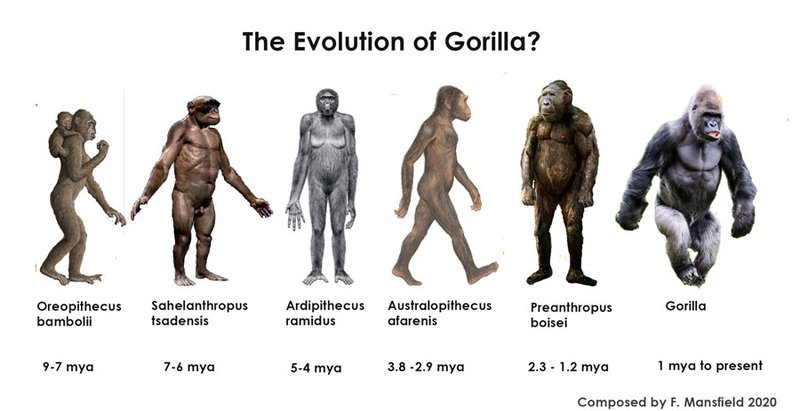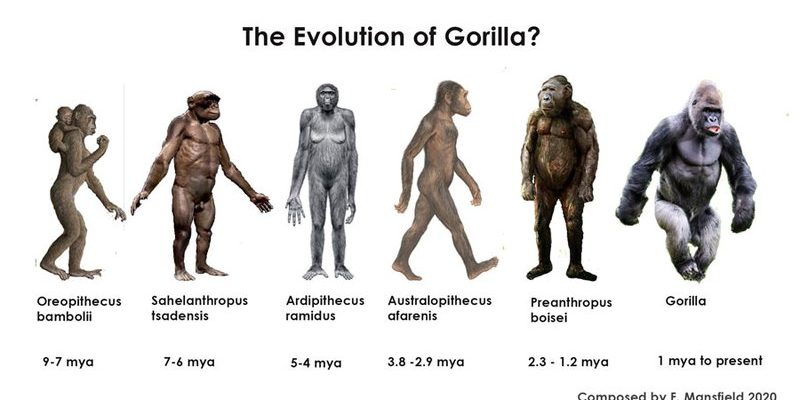
Imagine tracing back through a family tree that stretches thousands, even millions of years. Each branch represents a different ancestor, some familiar and others far from it. The history of gorillas is like that tree. It’s filled with twists, turns, and some surprising relatives. So, let’s take a stroll through this evolutionary timeline and see what makes gorillas tick.
The Roots of Evolution: Where Gorillas Came From
To truly appreciate gorillas, we first need to understand their ancient ancestors. Gorillas are part of the Hominidae family, which also includes chimpanzees, orangutans, and even humans. The story of gorillas begins with early primates that appeared around 60 million years ago. These primates evolved over time, branching into various species that adapted to different environments.
Around 8 to 10 million years ago, the common ancestor of gorillas and chimpanzees emerged. This ancestor likely roamed through the lush forests of Africa, living a lifestyle that combined tree-dwelling and ground activity. As climates changed, these primates adapted, leading to the eventual split between gorillas and their chimp relatives. This split set the stage for the unique evolutionary path that gorillas would follow.
You might be wondering, “What did these early ancestors look like?” Well, they were likely much smaller than today’s gorillas, resembling modern-day monkeys more than the massive giants we see now. This evolutionary journey was all about adapting to the environment, which meant growing larger and developing different social structures as conditions changed.
The Two Distinct Species of Gorillas
Today, we recognize two distinct species of gorillas: the Eastern Gorilla and the Western Gorilla. Each species has its own subspecies, and they vary in size, habitat, and behavior. The Eastern Gorilla is further divided into the Mountain Gorilla and the Eastern Lowland Gorilla, while the Western Gorilla includes the Western Lowland Gorilla and the Cross River Gorilla.
So, what’s the difference? Mountain gorillas are adapted to live in the cold, misty mountains of central Africa, with their thick fur helping them stay warm. On the other hand, Western Lowland Gorillas thrive in the dense jungles, where they primarily feast on fruit, leaves, and stems. Here’s the cool part: even though they’re different species, they share some common traits, like their social structures and intelligence.
Gorillas live in family groups led by a dominant male known as a silverback. This role isn’t just about size; it’s about responsibility. Silverbacks protect their group and make vital decisions, including where to find food and when to move. It’s like being the wise leader of a little clan, showing how strong social bonds are within gorilla communities.
The Importance of Social Structure
Speaking of social bonds, gorillas exhibit fascinating social structures that are key to their survival. They live in groups typically made up of several females, their offspring, and one or a few males. This family structure provides safety and support, which is essential for raising young gorillas.
Communication plays a crucial role in gorilla society. They use a variety of vocalizations, gestures, and facial expressions to convey emotions and intentions. For instance, a deep grunt might signal contentment, while a loud roar may alert the group to danger. This ability to communicate helps maintain harmony and cohesion within their families.
Gorilla babies are incredibly dependent on their mothers, especially in the first few years of life. A mother gorilla will care for her baby, teaching it about food sources and social interactions. This nurturing behavior ensures that the next generation learns essential survival skills, helping to further the species’ success.
The Role of Gorillas in Ecosystems
Gorillas aren’t just fascinating creatures; they play a vital role in their ecosystems. As herbivores, they help maintain the health of their habitats. By consuming vast amounts of vegetation, gorillas aid in seed dispersal, which encourages plant growth and diversity. Think of them as nature’s gardeners, fostering the landscape for future generations.
Their feeding habits also affect the structure of the forest. By selectively eating certain plants, gorillas contribute to the balance of plant life. Without gorillas, some plants might dominate the landscape, leading to less biodiversity.
This balance is crucial, especially with ongoing environmental changes. The loss of gorillas can create a ripple effect, impacting other species and the overall health of the ecosystem. Protecting gorillas means protecting the forests they inhabit and the countless other species that share their home.
Threats to Gorilla Populations
Unfortunately, gorillas face numerous threats that put their survival at risk. Habitat loss, mainly due to deforestation and human encroachment, is one of the biggest challenges. As forests shrink, gorillas lose their homes and food sources, leading to declining populations.
Additionally, poaching remains a significant concern. Some gorillas are hunted for bushmeat, and their infants are often captured for the illegal pet trade. This not only reduces gorilla numbers but also disrupts their social structures, making it harder for the species to recover.
Diseases, like Ebola, also pose a threat to gorillas. Outbreaks can wipe out entire populations quickly, especially if they’re already vulnerable. Conservation efforts are crucial in addressing these threats, working to protect gorillas and their habitats for future generations.
Conservation Efforts and Future Outlook
The good news is that various conservation initiatives are underway to help protect gorillas. Organizations such as The Dian Fossey Gorilla Fund and World Wildlife Fund focus on habitat preservation, anti-poaching efforts, and community education. These programs aim to empower local communities to protect gorillas and foster a sense of stewardship over their natural environment.
Ecotourism also plays a vital role. By promoting gorilla trekking experiences, local economies benefit while raising awareness about the need to protect these incredible animals. When people see gorillas up close, it fosters a connection that can lead to greater conservation support.
The future of gorillas hangs in the balance, but with ongoing efforts and global cooperation, there is hope. It’s a reminder that when we work together to safeguard our planet’s biodiversity, we can make a meaningful impact.
The evolutionary history of the gorilla is a remarkable journey full of adaptations, social bonds, and ecological importance. From their ancient ancestors to their current challenges, gorillas remind us of the interconnectedness of life. As we continue to learn from these magnificent creatures, it’s essential to take action to protect them and their habitats.
So, the next time you think of gorillas, remember their story and the role they play in our world. Whether it’s through supporting conservation efforts or simply spreading the word, we can all contribute to ensuring that gorillas thrive for generations to come. After all, when we protect gorillas, we protect a piece of our shared evolutionary heritage.

